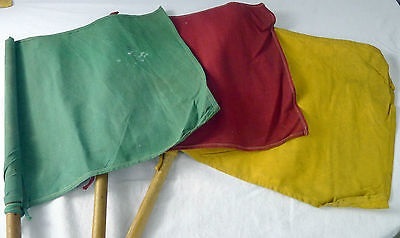
Tier I tanks used to come with "Signal Flags" as part of their basic radio system. Threads on the forum, reddit, etc. have asked, "Did WoT make this up? Did tankmen really use flags?"

Sure enough, the answer is 'yes' (in semaphore, as in the photo above). In a time when the "intercom system" could be as technical as kicking the driver to indicate which way you wanted to go, communications with the world outside the tank was even more difficult.

Just because tanks were coming standard with radios didn't mean that signal flags would be obsolete. In early 1941, Armored Force was trying to come up with its own visual signals guide, and that March approved the signals as found in Field Manual 17-5:
- "Disregard my movements:" Flag Stationary
- "Do as I do:" Raise and lower flag repeatedly
- "Assemble:" Wave flag in large circles
- "Form extended column:" Wave flag from font to rear, as determined by direction in which signaller's vehicle is facing
- "Form extended line:" Wave flag from side to side, as determined by direction in which signaller's vehicle is facing
- "Form column:" "Extended Column" signal, followed immediately by "Assemble" signal
- "Form line:" "Extended line" signal, followed immediately by "Assemble" signal
It was remarked by then-Armored Force Board president Col. John Kelley that "Attention is invited to the fact that this list of signals includes no signal for "Enemy" or "All clear." Experience in the regiments has shown that these two signals are more frequently used than any other."
For whatever reason, this was ignored. Two days later, a short reply came back from the MG Scott of Armored Force, saying "We're using FM 17-5 signals."
It would appear, however, that the FM 17-5 signals were not entirely satisfactory, because in December of 1941, another memorandum appeared, again from Col. Kelly. "Returned for further consideration per verbal instructions of the commanding general."
They then dragged out an earlier report from the last time they looked at it, crossed out the original date and put the current date in pencil, and re-submitted.

The listed requirements were:
- The system must be simple
- It must be easily committed to memory by enlisted men (Well, there's a vote of confidence in the troops --Chieftain)
- It must be incapable of misinterpretation due to any involuntary position of the signal flag
- Intervention of obstacles in the line of sight must not cause any misinterpretation
- The system must permit display of signals under battle conditions and in all weather conditions
- It should require a minimum of equipment
- Equipment must be sturdy and easily manipulated
The board thus found:
- That the required combat signals can be transmitted by three different colored flags
- That the familiar red, orange and green colors, long associated in the American mind with traffic signals, can be used, retaining the basic principles of red for "danger," orange for "caution" and green for "all clear."
- That the flag signals recommended for adoption will not interfere with the use of green flash-light signals for column control.
- That the Signal Corps lists in its catalog a flag type MC-49-6A1149 Red, MC-50 6A1150 Yello, and flag staff MC-43-6A2143. The flags therein listed are 18" square, of gallatea, with one loop and two tie strings for attaching to flag staff. The flag staff is a rod of oak, 24" long. (Regretfully, I've been unable to locate the test report files for the flags of these specifications. I'm sure that many hours and dollars were spent in selecting 6A2143 over the other contenders --Chieftain)
- That the efficiency of the flag signal system is considerably hampered by oil and grease accumulated in the tanks, which obscures the color of the flag.
With these as a baseline, the Board recommended the following flag signals:
|
|---|
It asked that Signal Corps come up with a green flag, and to coat all of the flags in Koroseal or some similar product (Basically a sort of synthetic rubber --Chieftain) to reduce the accumulation of oil or grease.
And thus came about the standard US Army-issue three-color flag set, handed out to armored force vehicles except passenger cars. Even today, three-color flags are issued, but they are only used as weapon status signals on the range.

Still, FM_21-60, "Visual Signals," is a valid field manual. That said, I don't think anyone still teaches "Stick your head out of the hatch and wave all three flags at once to signify a gas attack," no matter what the manual has to say on the matter.

The only inter-vehicle signal I have ever seen used outside of the classroom environment. Once.
Today, tactical communication by flag usually involves putting a really, really big colorful flag on your tank as a request to the US Air Force to please not shoot at you. This is unfortunately not a joke. The British Army in particular have had an unfortunate experience in such things, to the point that Briagdier Patrick Cordingley, commanding the Desert Rats in the 1991 war, ordered all vehicles to fly any flag they had as big as they had, and he "didn't care if it was the Bloody Red Hand of Ulster" if it caused the USAF to take pause.

Still, radios can always go down. I'll be surprised if any Army in the world has removed visual signals from their training regimen, regardless of how infrequently they are used.
